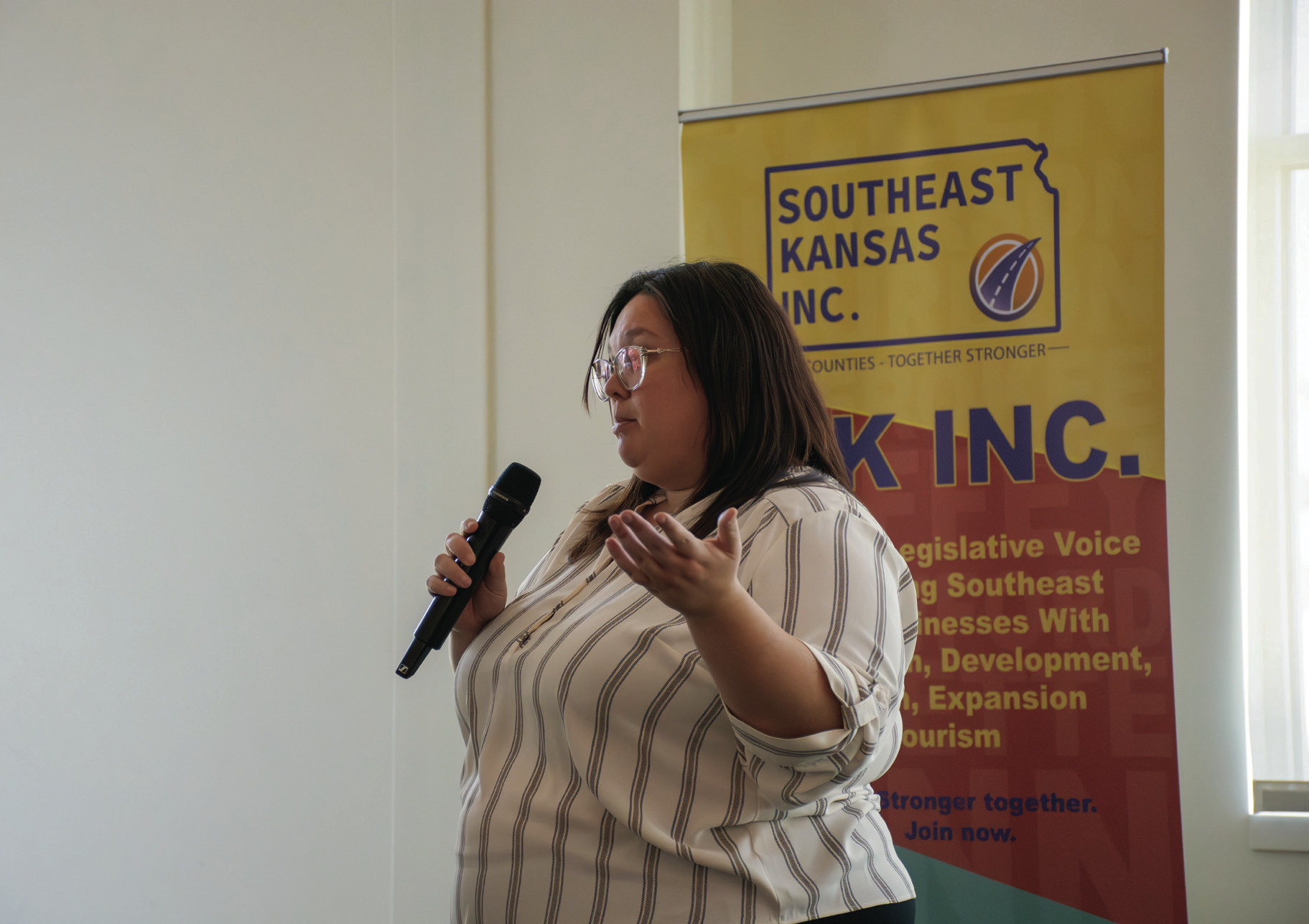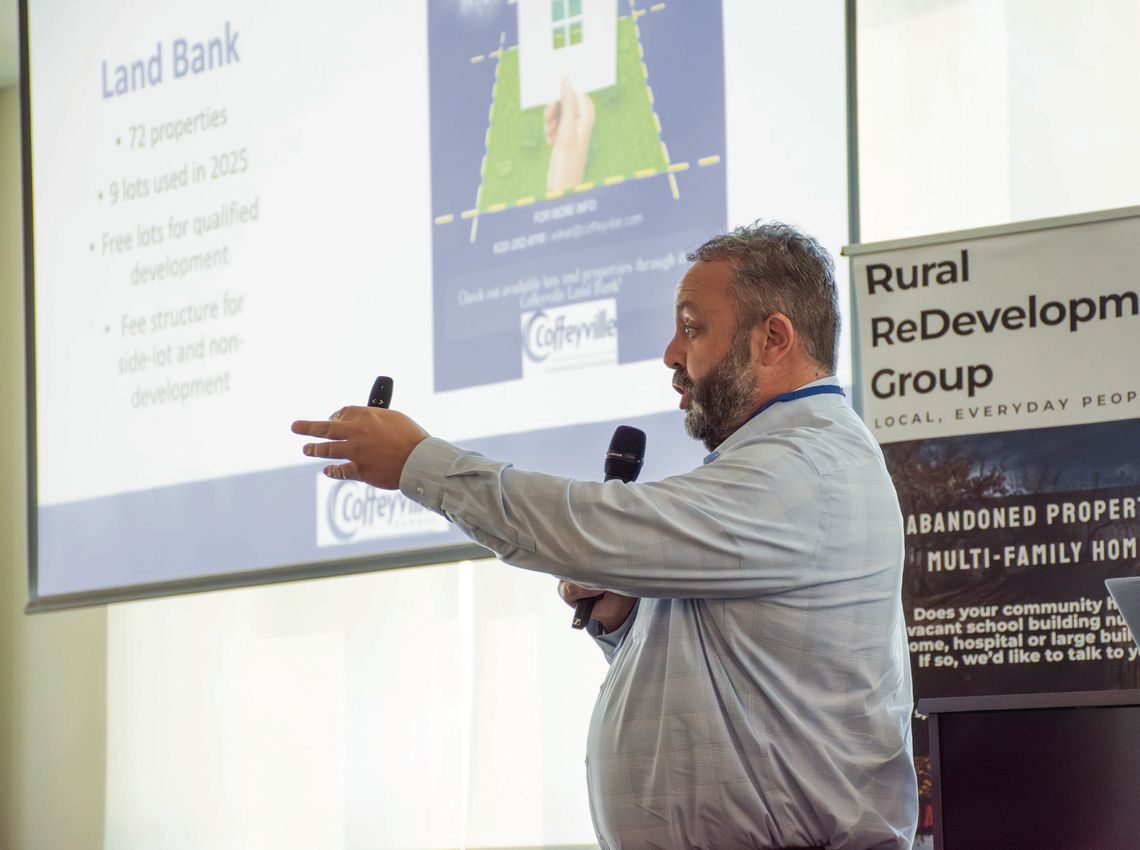Finding Home on the Range: How a southeast Kansas town uses a sales tax to fund housing projects, incentives, and repairs
Coffeyville — In Montgomery County, Coffeyville has taken a multi-pronged approach to addressing upkeep on existing homes and getting new homes built using sales tax monies.
This series is covering the ways in which southeast Kansas communities are thinking outside the box to create housing and economic development opportunities.
So far, this series has discussed how an innovative building trades program at Labette County High School has built homes in Altamont and Bartlett, and how Advanced Systems Homes has used grant funding to build homes and tax incentives to support new home buyers.
During Southeast Kansas Inc.’s most recent housing conference, Coffeyville City Manager Ben Brubaker and Director of Community Development Amber Dean spoke about what they have tested and what has worked for them.
In his opening remarks, Brubaker highlighted that there is a lot of opportunity in Kansas, coming from a man who has only moved to the state in recent years.
He also offered some background on Coffeyville’s unique challenges, including how the 2007 flood decimated the available housing stock. According to Brubaker, this decreased the housing inventory by roughly 300 homes.
When he came into the role of city manager, he said 120 homes were condemned and ready to be demolished. He also said that no new homes had been built in several years.
“When I came in, there was an interim city manager. That interim city manager, along with some of our staff were coming up with some ideas around USDA homes that didn’t really work,” Brubaker said. “So at this point, they had an employee with general contracting experience, and an employee from Arizona that had worked with large contract developers. They said, ‘You know what? Let’s try something. Let’s build our own homes.’” The City of Coffeyville took on the project of building two new homes in the community in 2024. The homes were a three-bedroom, two-bath, marketed at $163,000, and a two-bedroom, two-bath at $158,000.
Throughout the process, there were hiccups, according to Dean. The first of which was that the original contractor hired to frame the building backed out. Another issue was the cost of employee time, which wasn’t taken into consideration during the first budget presentations.
“This can’t be a reality — all the staff time we aren’t accounting for — the numbers look really good when you’re not counting your employees’ time and what you pay them.”
Brubaker said that there was a small financial loss on the project after factoring in employee time and salaries.
“The plan was: There is nobody here to build houses, and so the government should step in to build those houses,” Brubaker said. “So the plan was to do two, and if it worked, we were going to do four the next year, and then do six the year after that.”
While the project financially did not work out, it did spur the interest of local developers.
“A few months into starting, developers started showing up,” Brubaker said. He highlighted that Thomasville Homes has since built nine homes in Coffeyville.
Due to the interest of developers, the City of Coffeyville started and ended the home-building experiment after two homes.
Brubaker said one of the reasons they were even able to complete this project at all was thanks to a sales tax.
“And that really sets us apart there,” Brubaker said. “We have 40% of a half-cent sales tax, each year, for 10 years. So we’re getting about $400,000 a year dedicated to housing.”
It was these funds they were able to use to begin the house-building project.
“So over 10 years, Coffeyville’s got the benefit here of about $4 million,” Brubaker said.
He said that when he became city manager, there were two years where those funds had been untouched,
the sales tax also funds blight demolitions and grant programs for citizens and business owners.
Dean said the programs include first-time homebuyer assistance, Paint the Town grants, Senior Assistance, and developer incentives.
In an interview, Dean said these programs are hands-on by design.
“The city also makes use of the state’s Rural Housing Incentive District program to help reimburse development costs. Combining that with local programs and land bank property transfers to move projects forward. At the same time, maintaining rental licensing and offering homeowner programs helps keep existing housing stock in better shape,” Dean said. “Programs like Paint the Town provide paint and supplies so homeowners can quickly improve their properties. The Land Bank process has been made more transparent and accessible for both builders and residents. Incentives for multi-family housing are structured so they can be paired with RHID to close financing gaps. On top of that, Coffeyville Proud has created a volunteer base that helps with neighborhood improvement projects while keeping costs down.”
She noted that over the last two years, 15 developers have taken advantage of the single-family housing incentive, which offers developers $3,000 per home built. In total, 17 units have been developed through the multi-family construction incentive, which offers $1,500 per unit.
The emergency repair program has been used by 87 seniors. The program offers up to $1,500 for home repairs, paid directly to the contractor.
Dean said one hundred homes have gotten a new coat of paint through the Paint the Town program, which offers a $1,500 voucher to Sherwin-Williams for paint and painting supplies.
“Which doesn’t sound like a lot, but if you drive through Coffeyville, you see these homes, compared to how they looked — they look amazing. They look like brand new homes,” Dean said.
The homebuyers program offers $5,000 toward families purchasing their first home ever or those purchasing their first home in Coffeyville, which has been used by 15 families. Dean said the city frequently gets calls from realtors on behalf of their clients.
“It’s really drawn a lot of people into our community,” Dean said.
Brubaker said these programs and the growth have only been possible through the sales tax.
“That is a huge benefit that the community voted for,” Brubaker said.
Another piece of the housing playing field is a See TAX, Page 5.

Representatives from the City of Coffeyville discussed programs the city offers residents, and how building houses has brought more development to the community during this year’s Southeast Kansas Inc. Housing Conference. The top photo features Coffeyville City Manager Ben Brubaker, and the bottom photo features Director of Community Development Amber Dean. Hannah Emberton | Sun Photos
is a land bank, which currently has 72 properties. Dean noted that in recent years, nine total lots have been used by developers, often with stacking incentives.
Brubaker said part of the methodology is trying new ideas. “We’ve put up all these barriers for so long. How do we get rid of those and make this happen?”
Dean noted that the rural housing crisis can be felt in Coffeyville and other communities across the state.
“The impact of the housing gap on rural communities like ours is real. Employers have a harder time attracting and keeping workers. The local economy takes a hit when people can’t find housing close by, and families often end up with longer commutes or in overcrowded conditions,” Dean said. “State studies point to the need for thousands of additional homes in rural Kansas each year, which makes local action even more important.”
More stories of housing innovation will be shared in future parts of the Finding Home on the Range series.




